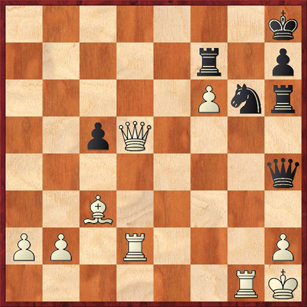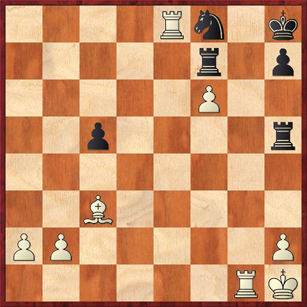Last weekend four people from Santa Cruz went to San Francisco to play in the Bagby Memorial at the Mechanics Institute. This was a one-day, five-round tournament with a fast time control, something like game/45. I would never be crazy enough to play in a tournament with those conditions — after five games, my brain would be totally fried!
Anyway, our Santa Cruz “gang of four” all did really well. Yosi Cohen and Jim Parker both scored 3/5, while Cailen Melville and Thadeus Frei scored 2/5. All of them except Yosi had very impressive ratings gains: Jim went from 1556 to 1647; Cailen went from 1628 (provisional) to 1662 (provisional); and Thadeus went from 1585 to 1655. Not only that, Thadeus beat his first master (Keith Vickers)! He also drew an expert (Dmitry Vayntraub)Â who was rated 2175. Ironically, Cailen also beat Vayntraub. That guy must be wondering what hit him.
Hopefully I’ll get Thadeus to show me the games, if they are any good.
Today we had one of our biweekly Sunday quads and blitz tournaments. (Game/30 for the quads, game/7 for the blitz.) We had four experts in the top quad: Pablo Pena, Dan Burkhard, Ashish Mukharji, and me. Ashish came all the way from San Jose after reading about the Sunday afternoon chess tournament in my most recent post (New Kid in Town), and e-mailing me to find out the particulars. Unfortunately, we gave him a rather rough welcome to Santa Cruz chess. The final results were: Dana 2½, Pablo 2, Dan 1½, Ashish 0. Better luck next time, Ashish!
I beat Pablo and Ashish, then played a short draw against Dan. Unfortunately I don’t remember the game against Ashish well enough to reconstruct it, although it had a rather nice finish. Against Pablo, I was lucky enough to catch him in a line of the Benko Gambit (where I was White)Â that he didn’t know very well: 1. d4 Nf6 2. c4 c5 3. d5 b5 4. cb a6 5. e3. Objectively speaking, the game was kind of a rout, but there was an interesting moment near the end where he set a fiendish trap. (PGN of the full game is here.)
White to move. Did Black just hang a rook?
At this point I have about 2 minutes left on my clock, and he has less than a minute. Either Pablo did a heck of an acting job, or else he got really lucky here. He has just moved 32. … Nf8-g6, leaving his rook on prise. He grabbed the knight, then looked appropriately shocked, and then moved it to g6 with a forlorn expression of “Okay, put me out of my misery now.”
It totally fooled Dan Burkhard, who was watching. But it didn’t fool me. If White plays 33. Qxf7?? then Black either draws or wins! The answer is 33. … Qe4+! If 34. R2g2 then Black has an exquisite mating combination, 34. … Rxh2+!! 35. Kxh2 Qh4 mate. If 34. R1g2, then Black has a perpetual check with 34. … Qe1+.
So I steadied my nerves, took a deep breath, and played the simple move 33. Re2!, which defends the queen check and threatens lots of nasty back-rank stuff. Whereupon Pablo left his rook en prise again with 33. … Qh5!?
Now this time, it turns out, Black’s rook sacrifice is not sound. After 34. Qxf7 Qf3+35. R2g2 Rxh2+ 36. Kxh2 Qh5+ because the check is on h5, not h4, White’s king can escape with 37. Kg3, and eventually reach shelter on the queenside. But with less than 2 minutes left on my clock, you can understand why I was not completely sure, and decided to play simply with 34. Qxh5! Rxh5 35. Re8+ Nf8.
White has a million ways to win. What is the most elegant way?
Here I continued to play practical chess, and played 36. a4? because I didn’t see how he would stop my a-pawn. Pablo played 36. … h6 37. a5 c4 and only now, for some reason, it dawned on me that 38. Rg7! is absolutely crushing. That was the move I played, and after he thought for a few seconds his flag fell.
In the diagrammed position, of course 36. Rg7 is overwhelming. But certainly the most elegant finish is 36. Rxf8+! Rxf8 37. f7+ Re5 38. Bxe5 mate!
The irony is that earlier in the game I had been trying to set up this exact mating net, but by the time we got to the position in the diagram my brain had switched to “endgame mode” and I was not looking for mating combinations any more. In my defense, let me also say that in blitz chess, or any time when you’re down to your last minute or two, if you have a winning position it is much better to play a safe and solid move rather than waste your time looking for an elegant one. So that’s what I did for two moves, until I finally got more oriented in the position and realized that I had an immediate crusher.
Pablo got his revenge in the blitz tournament. He won our individual game, and he won the tournament as well, with 5.5 points out of 6. I had 5 out of 6. Curiously, out of the 21 games in the blitz tournament, there was not a single upset. The higher-rated player (using Santa Cruz chess club ratings, not USCF) won 19 games, and there were 2 draws.





{ 1 comment… read it below or add one }
In your first diagrammed position, I like(d) the look of Qd8+ followed by QxNf8+ and then f6+ and R2g2, or on the safer but less flashy side, perhaps R2g2 as the second move in the sequence.
Chess is so much easier as a spectator …
{ 1 trackback }